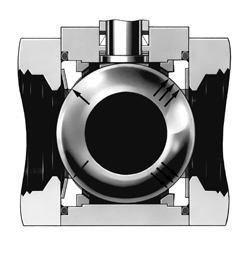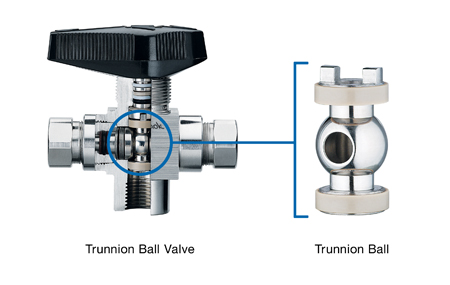Fugitive emissions from production plants are attracting increasing interest from legislators. Here Michael Adkins and Pete Ehlers, of Swagelok, describe how to choose a ball valve to curb fugitive emissions
More and more attention worldwide is being focused on fugitive emissions. Fugitive emissions are defined variously and may refer to a wide range of emissions not confined to a stack, duct or vent, including emissions from bulk handling or processing of raw materials, windblown dust and other industrial processes. In fact, any leaks that pose harm to the environment are fugitive emissions.
US regulations are homing in on fugitive emissions in regions such as the Gulf Coast of the United States. The European Union’s Integrated Pollution Prevention and Control Bureau (IPPC) issued a comprehensive directive to curtail fugitive emissions. Effective for new construction since 1999, the directive applies to maintenance, repair and upgrades at existing production facilities effective since October 2007.
With respect to emissions in general, and fugitive emissions in particular, the trend is clearly towards higher standards and more scrutiny. Fugitive emissions will be in the vanguard as regulators attempt to impose the next set of emissions standards, especially as regards highly reactive volatile organic compounds (HRVOC).
In this article, we will focus on external leaks from ball valves. To control fugitive emissions from ball valves, the critical point is to select the right ball valve for the application. This article will focus on two design features that are particularly important in controlling fugitive emissions: body seal design and stem seal design.
body seal design
Two common types of body seals are screw type and flange type. While the screw type is a stronger seal, enabling higher system pressure, the flange type allows fast and easy maintenance with the valve in line.
The screw type consists of one or two threaded “end screws” that screw onto the body of the valve after the ball and seat packing have been loaded inside. The sealing area of a screw-type fitting is relatively small and it can be an especially efficient seal, enabling effective sealing at pressures as high as 10,000 or 20,000 psig (689 or 1378 bar). In addition, the design enables a wide range of end connection choices.
In valves employing the flange-type body seal, the valve body consists of three discrete sections that are joined together with flanges, seals and bolts (Figure 1). Because the sealing area across these components is larger, this design usually results in a lower pressure rating.
Since the flanges are sealed with gaskets, there are fewer geometric constraints on the sealing material, and therefore a wider choice of sealing materials is available. Another advantage of the flange-type design is the ease of maintenance.
stem design
In a ball valve, there must be some means of ensuring that the system media does not leak from the stem and body interface. This is the role of the stem seal. With sufficient cycling frequency, all stem seals are subject to wear, and wear can lead to leakage. However, some seals are more effective than others in certain applications.
One-Piece Stem Packing
The most basic and primitive technology is a one-piece gasket that encircles the stem. As the packing bolt is tightened down on the stem, the gasket, usually made of polytetrafluoro- ethylene (PTFE), is crushed, filling the space between the stem and the body housing.
Unfortunately, PTFE and other similar packing materials are subject to cold flow, which can be exacerbated by pressure and temperature. In some cases, the material may extrude into unintended areas, leading to leakage of system media.
To reduce the risk of fugitive emissions, the one-piece packing design should be reserved for applications with minimal fluctuations in temperature and pressure, limited cycling and where inspection and monitoring will be frequent and regular.
Two-Piece Chevron Stem Packing
A two-piece chevron stem packing design allows for wider temperature and pressure ranges, and regular and easy actuation without excessive wear. A chevron packing consists of two matched gaskets, one fitting inside the other. With minimal pressure from the packing nut, a substantial seal is created between the stem and the body housing.
For the chevron seal to work correctly, the two PTFE gaskets must be held in place to reduce cold flow during thermal cycling. The packing must be adequately contained and supported by packing support rings and glands, which distribute pressure evenly.
To reduce the interval of inspection and adjustment, the chevron design may also include Belleville washers, which are springs that create a ‘live load’ on the packing. Live loading enables even pressure on the packing, as temperatures and pressures fluctuate. The result is easy actuation and minimal wear to the packing.
O-ring seal
Another effective stem seal technology is the O-ring. When properly designed, this technology provides flexibility for situations requiring high pressure, low pressure, or a broad pressure range.
The O-ring is usually made from a highly elastic material, such as fluorocarbon FKM. A proper stem design with an O-ring configuration requires a back-up ring or some other mechanism, usually made of PTFE, which will contain the O-ring under high pressure. In terms of temperature, pressure and chemical attack, the design is limited by the specifications of the elastomer.
stem misalignment
Beyond issues relating to stem seal design, there are some additional causes of leaks from the stem. These have to do with alignment of the stem.
There are two basic causes of misalignment. In the first case, misalignment may result from improper installation of the actuator. If the centre line of the actuator and the centre line of the stem are not properly aligned, the stem will become tilted, resulting in uneven wear of the stem seal.
In the second case, damage to the seat seal inside the valve may cause the stem to tilt. Ball valves can employ either a floating or trunnion ball design.
In a floating ball design, the ball is not fixed inside the housing but floats between two seats. In the shutoff position (Fig. 3), the ball seals against the seat on the low-pressure side, pushed downstream by a positive pressure differential.

Figure 3 shows a cross section of a floating ball valve in the shut position, with downstream pressure pushing the ball to seal on the right hand side. Arrows point to the seat seals
The trunnion design also employs a ball, but in contrast to the floating ball design the ball is not a discrete sphere. Rather, its geometry includes two cylinders – the ‘trunnions’ – affixed to the ball at the top and bottom (Fig. 4). The unit fits into a space in the valve body and cannot move along the flow axis.

Figure 4 shows a trunnion ball valve
In the case of high differential pressure across the seat, a free-floating ball can be pushed too far downstream. In the absence of an advanced seat design, such as a spring energised seat, the ball may not return to the centre position. As a result, the stem will tilt to one side, and uneven stem wear will occur.
The trunnion design prevents excessive movement of the ball downstream. The trunnions, which are fitted in place, keep the ball centred and the stem properly aligned.
In summary, different designs have different strengths and relative merits, and these have a direct impact on fugitive emissions. The real cost of a valve is not the purchase price but the overall cost of ownership. With raw material feedstock prices increasing, as well as the frequency and severity of environmental non-compliance fines, direct and indirect costs associated with frequent maintenance, failure and replacement must be considered.
